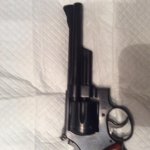The replies in this thread have been interesting and informative.
Every S&W I own has a turn line, including the stainless steel and nickel models.
Don't reblue, and don't fret about the turn lines.
Rebluing might have a more adverse value result than turn lines.
Every S&W I own has a turn line, including the stainless steel and nickel models.
Don't reblue, and don't fret about the turn lines.
Rebluing might have a more adverse value result than turn lines.




